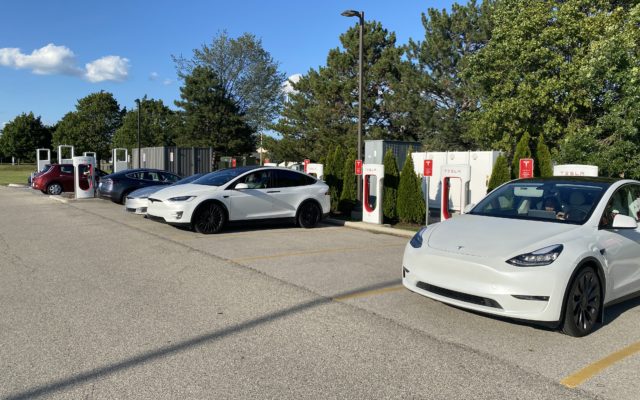From Pumps to Plugs: A Look at Electric Vehicles in the Great Lakes Bay Region

Listen to the full report:
Electric vehicles have been hyped as the next wave of transportation, but with gas prices on the rise in 2021, what goes into moving away from the combustion engine and towards something many people are still unsure of? We spoke with owners who have already made the switch, to learn their experience so far as part of WSGW’s series on electric vehicles, “From Pumps to Plugs.”
With President Joe Biden’s August 5th executive order aiming to transition 50% of all passenger vehicles sold to electric by 2030; wary businesses and consumers have been asking what changes they’ll need to make to better utilize upcoming grants and infrastructure being put in place by the U.S. Department of Transportation and U.S. Department of Energy.
Bay City resident Chris Smith, owner of a Nissan Leaf, says his recent decision to purchase an electric vehicle was based on the recent uptick in gas prices, and his day-to-day routine.

Smith adds that because he lives close by, he’s able to use the Supercharger station at the Wilder Rd. Meijer store. An average charging session for Chris is just over $3.00, with a total from May 10th through August 24th of $75.25.
Despite the comparatively lower user cost at the pump, electric vehicle owners at the Supercharger say there’s a general shortage of fast charge stations as EV’s become more prevalent. Dr. Rashad Farha is a Tesla owner and physician working in Sault Sainte Marie who regularly drives from Ann Arbor:
As business owners adapt to an uptick in electric vehicles, more have been adding charging stations, but many say it’s still not enough.

Sean Oppermann, is the owner of both a Chevy Volt and Midland’s Cork ‘n Ale on East Patrick rd.- one of the few independent businesses in the area offering a station for vehicles to charge up. Oppermann says Cork ‘n Ale made the addition using the Consumers Energy PowerMI Drive program to assist with installation costs, but adds other retail facilities will need to start adding stations as EV’s become more common.

The PlugShare app, used by many electric vehicle owners in search of a place to recharge, shows that in the city of Midland (not including car dealerships) there are only four registered locations available for public use. That’s one quarter of the 16 gas stations within city limits- six of which are on N. Saginaw Rd. within a mile-and-a-half stretch, and within a half-mile of each other.
A wider view of the Great Lakes Bay region shows about 60 charging stations registered from as far north as Standish to as far south as Flint. Many of these are either registered to car dealerships, hotels, or camp sites; or only offer a singular 50-amp/240-volt or lesser plug.

With dealers holding such a prevalent footprint on the EV charging station map, car dealerships are starting to acknowledge both EV popularity as well as an impending loss of income from a drop in maintenance visits. Many EV drivers, like Opperman or Tesla owner Kevin Rooker, say they chose their cars because of the need for fewer repairs and service.
Officials from both Garber Chevrolet in Midland and Thelen Audi-Volkswagen in Bay City confirmed those statements. General Manager Joe Thelen and his EV Specialist, Lonzo Simmons, say as electric charging infrastructure grows and the cars become more prevalent, they expect the need for service to slowly drop off, since the vehicles don’t require much in the way of oil changes, transmission checks, or other tune-ups.
Thelen and Simmons say prospective customers often have questions about vehicle range. While an early-model Nissan Leaf may have gotten fewer than 100 miles on a full battery, many recent productions have more than tripled that. Thelen calls today’s concerns about drive distance “range anxiety.” Some people interviewed said they wouldn’t want an electric vehicle until it can go 1,000 miles on a full charge. The term “range anxiety,” while applicable to any car, has been mainly used to reference one of the biggest barriers to large-scale electric vehicle adoption. Thelen says the mileage newer EVs offer shouldn’t discourage buyers, especially when compared to the output of gas powered cars.

Within the last 5 years, cars like Tesla’s Long-Range Model S are hitting more than 400 miles on a full battery, and Ford’s upcoming F-150 Lighting is estimated to have a 300 mile extended range package but that number increases significantly without the 1000lb load used in EPA examples.
Thelen adds that in addition to these cars nearing the range of their gas-powered competition, and offering services like Home-Power backup (in Ford’s case), they should last nearly twice as long.
The cost to drive a vehicle is also cheaper when comparing a $3.16 gallon of gas in a 30 mile-per-gallon tank, to the $3.00 cost to recharge 90 miles in a 2015 Nissan Leaf.
With costs and repairs taken into account, does it feel any different to drive an electric vehicle? The cranking of an ignition, the rev of an engine, and the smell of gasoline are some things missing from the driving experience when you choose an EV. My experiences of driving electric vehicles were vastly different depending on the make and model.
While speaking with Chris Smith (a close friend of mine from Bay City who let me drive his Nissan Leaf), the trip from the Meijer Supercharger to the Bay City Mall felt like driving any other gas-powered car- aside from the regenerative braking, that is. Chris said I didn’t need to completely hit the brakes, and it felt like the re-gen brakes slowly gripped the wheels until they came to a stop, using that resistance to slightly charge the vehicle.
Lonzo Simmons, from Thelen Audi-Volkswagen, took me on a test ride of the 2021 Audi e-tron, which had a much different feel than the Leaf.

The acceleration kick in the Audi e-tron, as well as the Tesla Kevin Rooker was nice enough to let me peel-off in, were enough to make me think I’d need to consider wearing a helmet to drive. The biggest difference between the two was the self-driving capability of the Tesla.
Taking off like a rocket and self-driving may be very appealing, but when the battery lights come on saying “it’s time to charge,” you still have to find one of those currently-scarce charging stations.
The city of Saginaw recently announced the addition of several new charging stations, but when will there be enough to satisfy the growing EV Market? Two sites opened earlier this week in the Ippel “Sign Park” parking lot (110 S. Hamilton Ave) and offer DC-Fast Charging. Six other “Level 2” 240-volt charger plugs have been split between the area surrounding the SVRC Marketplace, and up the street from the fast charger on Hamilton. These eight stations are a welcome addition, but they’re located in the heart of the city of Saginaw, not off a highway exit like many gas stations are.
While they may appear to be a godsend for Kevin Rooker, who lives nearby with his Tesla; even he says more need to be installed to meet future demand, otherwise they won’t make total sense.
The Beaver Rd. Mobile station charger in Kawkawlin and the Bay City Supercharger are directly off their freeway exits, but they’re within a short drive of each other and a long drive for EV owners anywhere else in the Great Lakes Bay Region. Because of that, Rooker says he mostly charges his Tesla at home.

So much more still needs to be learned about electric vehicles before many will be convinced to make the investment.
A big question is, when will the majority of EV’s be priced more affordably? Also, are there any disparities between those who own EV’s and those who don’t? Many of the owners interviewed were (unintentionally) either Caucasian, or someone in a higher wage job like Dr. Farha or Lonzo Simmons.
Another question: what are the quality or safety concerns of these vehicles considering the recent Chevy Bolt battery recall?
Only time will tell as the impact of these mechanical marvels stretches across the socioeconomic spectrum.
You can also listen to each segment of From Pumps to Plugs as originally aired on 100.5FM & 790AM:



